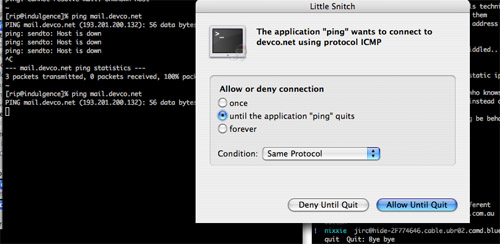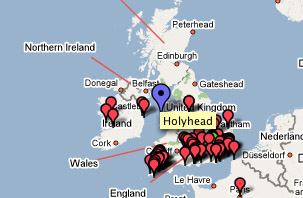by R.I. Pienaar | Jul 6, 2006 | Photography
A problem with DSLR’s seem to be that images tend to be a bit soft and fuzzy some times, this might just be because I do not spend 1000 pound on each lens or it might be a general problem. Regardless a solution exist in Photoshop.
Photoshop has a number of sharpening tools the most used one being the oddly named Unsharp Mask (USM). 100s of websites cover the USM and its drawbacks, a good one can be found at The Luminous Landscape. The short of it, too much sharpening a image leaves artifacts on your image like little halos and stuff.
Photoshops CS2 has a better sharpening tool called “Smart Sharpening” but I still prefer a bit of USM, I found a article that discusses both these sharpening tools and gives a sample technique for using the USM on edges of your image only, this effectively removes the problems with halos and so forth and means you can be more aggressive with sharpening your images.
I tried out the above edge sharp technique and really like it, I was considering buying a commercial sharpener but now I decided against it in favor of this technique.
I have a sample image up done with this method you can see the before and after.

I’ve made a Photoshop action for this technique, tested in CS and CS2. It’s very simple it should be the last thing you do to your image right before putting it on the web. Don’t sharpen your full size image then resize it, first resize and then sharpen. Sharpening is as easy as running this action and after some steps it will show a standard USM dialog with preview, you should immediately see the results by dragging the sliders.
The action can be found here, just drag it onto your Photoshop and look in the Actions Palette
by R.I. Pienaar | Jul 6, 2006 | Uncategorized
The OS X Operating System might be free of virii and trojans at the moment but I cannot imagine this situation will last. Also being free from malicious code doesn’t prevent otherwise trustworthy companies from ‘phoning home’ as is the case with OS X 10.4.3.
In the windows worlds the obvious answer is to just get the free edition of Zone Alarm but sadly there is nothing free in the Mac world.
I’ve often come across mentions of Little Snitch so I figured I’ll check it out, from its website:
You start an application that tells you that a new version is available. You suddenly realize that with every start this application connects to the developer’s server. Even statistics information about your computer may be sent this way. Little Snitch helps you avoid this situation.
Trojan horses – i.e. programs transmitting unconsciously data stored on your computer – can be detected by Little Snitch and prevented on the transmission of data.
So I tried its free demo for a few days and last night bought it via PayPal thanks to the strong Pound it was a bargain, below is a screenshot of it in action showing it even blocks shell commands etc.

I can really recommend this app, grab a copy if you are concerned about privacy and general security on your Mac.
by R.I. Pienaar | Jun 19, 2006 | Code
There is a new version of GMapEZ that brings with it some new features, I’ve implimented some of these into GMaps PHP.

As you can see from the screenshot above the map now supports varying sizes of markers, the small ones are good for maps with lots of points but obviously they do not support any kind of text on the marker.
To activate mini icons for a specific type of point you need to edit your config file:
[types]
visit = orange mini
transit = blue
lived = green
The above configuration snipped will make any points of type visit to be small markers.
The other change in this version is simply a little mouse-over window that will show the title of any point when you hover over it, activating this feature does not require any config changes.
These features will only be available to you if your config file points to the latest version 2 of GMapEZ:
[misc]
gmapez=http://bluweb.com/chouser/gmapez/gmapez-2.js
There is one more feature in GMapEZ 2.2 that I did not include in this release, it supports tabbed popup windows, if anyone need these please drop me a line and I’ll look at including them.
GMapEZ also supports drawing lines, I may include support for these if there are demand for it, personally I don’t need them but if someone does, leave a comment here and I’ll keep it in mind for the next release.
Upgrading from 1.4 to 1.5 is really simple, simply replace the gmap.inc.php from your site with the one in the tarball below. Then make the optional config change above if you’d like mini icons.
As always you can get the latest version at http://www.devco.net/code/gmapsphp-current.tgz and full documentation can be found on my Wiki
by R.I. Pienaar | May 20, 2006 | Code
The author of GMapEZ released a new version of his javascript that supports the new version of Google Maps.
I’ve had some mails asking me to support the new version but as it was in Beta till this morning I delayed doing a full release of the new code till now.
Upgrading from 1.3 to 1.4 is really simple, simply replace the gmap.inc.php from your site with the one in the tarball below. You also need a small change in your config file for your map, the url to the GMapEZ has changed:
[misc]
gmapez=http://bluweb.com/chouser/gmapez/gmapez-2.js
With this in place, if you open a map it should still look roughly the same, but if you scroll over France – or in fact all of Europe – you’ll see street level maps now, in future some of the newer Google features are likely to be supported.
Get the code at http://www.devco.net/code/gmapsphp-current.tgz, full documentation can be found here
by R.I. Pienaar | Apr 6, 2006 | Usefull Things
I’ve been a fan of virtualization for some time, been a very early user of VMWare years ago in fact version 2 of my iScan appliction was written entirely inside VMWare while stuck in a hotel in Athens around 2001. Things since then has come a long way especially on Intel hardware.
Intel has introduced their Virtualization Technology extensions on their recent chips to enable the CPU to run multiple operating systems on the actual CPU, much like main frames have been able to do for ages.
Virtualization enhanced by Intel Virtualization Technology will allow a platform to run multiple operating systems and applications in independent partitions. With virtualization, one computer system can function as multiple “virtual” systems. With processor and I/O enhancements to Intel’s various platforms, Intel Virtualization Technology can improve the performance and robustness of today’s software-only virtual machine solutions.
I’ve been very excited to get my hands on both hardware and software together that lets me explore this exciting technology and today that was delivered in the form of my Apple iMac Core Duo machine running Parallels Workstation.
Parallels Workstation 2.0 is the first desktop virtualization solution to include a lightweight hypervisor, a mature technology originally developed in the 1960s to maximize the power of large mainframes. Hypervisor technology dramatically improves virtual machine stability, security and performance by using a thin layer of software, inserted between the machine’s hardware and the primary operating system, to directly control some of the host machine’s hardware profiles and resources. It not only makes Parallels Workstation-powered virtual machines secure, stable and efficient, but also empowers users to immediately realize the benefits associated with Intel VT hardware virtualization architecture.
The good thing is it works on OS X on Intel hardware and allows you to run most operating systems. I grabbed a copy of FreeBSD 6.0 and immediately knew it was fast, only later did I realise how fast.
I wanted to see if I can get my 2nd Core to appear as a 2nd CPU in the guest system so I built the included GENERIC SMP kernel, the build time was just short of 17 minutes. The VM was allocated 256Mb RAM and was running on my 1800mhz Intel iMac. At the time I had Thunderbird, Deerpark, NetNewsWire, Terminal, Adium, Activity Monitor and MS Word (under Rosetta) open.
I then took my AMD 1800Mhz with 512Mb RAM machine also running FreeBSD 6.0 and did the same build, the build time on that was 18 minutes.
I realise this isn’t the most scientific of tests, but it far exceeds any performance indication on any VM I’ve ever seen, I’m really looking forward to one day having a Bladecenter full of machines capable of running this technology and doing a full VMWare based architecture, the advantages that virtualization brings to the table is staggering. If you ever get a chance to see a real demo of VMWare’s enterprise products I’d strongly suggest you jump at the oppertunity.




